View in other NatureServe Network Field Guides
NatureServe
Montana
Utah
Wyoming
Idaho
Wisconsin
British Columbia
South Carolina
Yukon
California
New York
Tall Hairy Groovebur - Agrimonia gryposepala
Native Species
Global Rank:
G5
State Rank:
S3S4
(see State Rank Reason below)
C-value:
6
Agency Status
USFWS:
USFS:
BLM:
External Links
State Rank Reason (see State Rank above)
Agrimonia gryposepala occurs in southeastern Montana where it associates with hardwood draws and open woodlands, sometimes along streams. The first observation was made in 1886 and all other known occurrences have been found since 1983. Recent floristic surveys have found more occurrences indicating that observations may be more limited by the scarcity of botanists than by the species. Additional data on locations, population sizes, threats, and trends is greatly needed.
- Details on Status Ranking and Review
Population Size
ScoreU - Unknown
Range Extent
ScoreF - 20,000-200,000 sq km (~8,000-80,000 sq mi)
Area of Occupancy
ScoreD - 6-25 4-km2 grid cells
Number of Populations
ScoreB - 6 - 20
Environmental Specificity
ScoreB - Narrow. Specialist or community with key requirements common
Threats
ScoreD - Low
CommentThreat categories include: Habitat shifting & alteration and livestock grazing. Hardwood draws can be overused by livestock or altered by manmade activities.
General Description
Plants: Perennials with erect stems, pinnate leaves, and egg-shaped, leafy stipules (Lesica et al. 2012). Plants produce one to several short rhizomes (about 5 centimeters) that usually have one bud each (Kline and Sorenson 2008). Roots are fibrous (Kline and Sorenson 2008). First-year seedlings generally have a few three-parted leaves. Second year plants grow a stem and flowers (Kline and Sorenson 2008). Across the entire species range, plants can be 35 to 150 centimeters tall (Kline and Sorenson 2008).
Leaves: Larger leaves have 5 to 9 leaflets, which are serrate and oblanceolate, 1 to 4 centimeters long, and glandular beneath (Lesica et al. 2012). The terminal leaflet is the largest (Kline and Sorenson 2008).
Inflorescence: Narrow, glandular, bracteate raceme (Lesica et al. 2012).
Phenology
Typically flowers July to mid-August (Kline and Sorenson 2008). Before plants go dormant in the fall they grow a structure resembling a basal rosette. It actually is a short stem with a small cluster of leaves on internodes that are only a few millimeters apart. The next year, this section grows into the flower-bearing stem (Kline and Sorenson 2008).
Diagnostic Characteristics
Distinguishing the types of pubescence (use a hand lens) and their distribution on the plant is essential for identifying Agrimonia species (Kline and Sorenson 2008). There are four types of hairs: short-stalked glandular; sessile, glistening glandular; non-glandular soft (either straight or wavy); and non-glandular stiff and straight (hirsute). On its upper stem, A. gryposepala has both types of glandular hairs and hirsute non-glandular hairs (erect and about 2 millimeters tall). In contrast, A. striata has soft and hirsute non-glandular hairs (Kline and Sorenson 2008).
The mature fruits of A. gryposepala are fairly distinctive, with the lowermost row of hypanthium bristles reflexed. In comparison, the lowermost bristles of A. striata jut out at a 90 degree angle (Kline and Sorenson 2008). Stipules differ slightly: those of A. gryposepala are half-egg-shaped and incised, while those of A. striata are more sickle-shaped and either incised near the base or mostly entire (Kline and Sorenson 2008).
Species Range
Montana Range
Range Descriptions
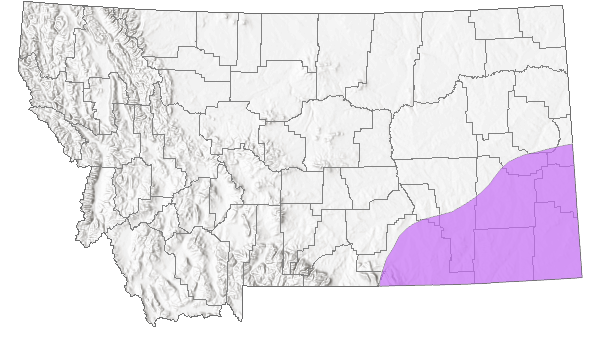
 Native
Native
Range Comments
Cascade and Carbon counties; MT to ON south to KS, MO, IN and NC (Lesica et al. 2012. Manual of Montana Vascular Plants. BRIT Press. Fort Worth, TX).
Observations in Montana Natural Heritage Program Database
Number of Observations: 14
(Click on the following maps and charts to see full sized version)
Map Help and Descriptions
Relative Density
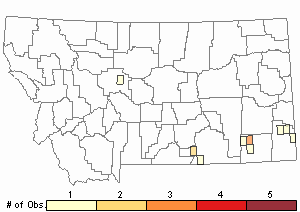
Recency
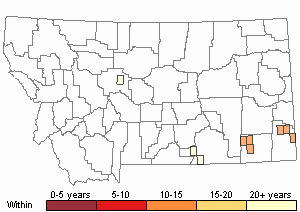

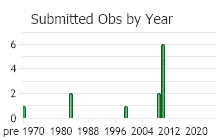
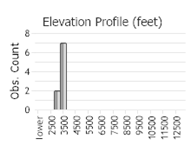 (Observations spanning multiple months or years are excluded from time charts)
(Observations spanning multiple months or years are excluded from time charts)
Habitat
Found in hardwood draws and in open woodlands, sometimes along streams. In plains, valleys (Lesica 2012).
Ecology
In a New York study, survival of Agrimonia gryposepala seedlings did not change as the biomass of non-native earthworms increased, while twelve other forest understory plants showed decreased seedling survival. The negative impacts to most species were thought to be connected to a reduced leaf litter layer leading to greater moisture stress, erosion, and frost heave. A. gryposepala plants grow quickly and have a relatively broad ecological tolerance that includes younger forests and some disturbance. Indeed, A. gryposepala survival was reduced on sites with low light levels (as indicated by an increase in Leaf Area Index) (Dobson and Blossey 2015).
Reproductive Characteristics
Flowers: The petals are 3 to 6 millimeters long and light yellow. The ovary is surrounded by a fused structure (hypanthium) which has 10 grooves on the outside and hooked bristles above. The grooves are glandular but lack stiff hairs (Lesica et al. 2012). There are around 15 stamens (Lesica et al. 2012). One to several flowers reach anthesis at once (Kline and Sorenson 2008). At this point, the stamens spread out but bend back in during the day, self-pollinating the flower if it has not been cross-pollinated (Kline and Sorenson 2008).
Fruit: The hypanthium expands to become 3 to 5 millimeters long and hardens as its bristles unfurl (Lesica et al. 2012; Kline and Sorenson 2008). It encloses a single round achene about 3 millimeters wide (Lesica et al. 2012). The mature fruit has four to five rows of bristles, with the lowermost row bent down below horizontal (Kline and Sorenson 2008).
Management
Before germinating, fruits need to experience temperatures of 2 to 5 degrees Celsius for about two months in moist soil. Seedlings appear from 10 days to 3 months after this cold stratification (Kline and Sorenson 2008).
Agrimonia plants contain tannins and are used medicinally to tighten tissues (astringent), to stimulate the liver (cholagogue), to aid digestion (stomachic), and to reduce inflammation (antiphlogistic) (Cernaj and Oravec 1993).
A solution of ground-up stems, leaves, and roots in an organic solvent such as acetone or ethanol inhibits growth of certain bacteria, including Staphylococcus aureus. This extract remains effective when exposed to heat of up to 100 degrees Celsius and is non-toxic to humans (Jensen and Miller 1951).
Stewardship Responsibility
References
- Literature Cited AboveLegend:
 View Online Publication
View Online Publication Cernaj, P. and V. Oravec. 1993. Variability of active substances in Agrimonia L. species. Acta Horticulturae 330:133-136.
Cernaj, P. and V. Oravec. 1993. Variability of active substances in Agrimonia L. species. Acta Horticulturae 330:133-136. Dobson, A. and B. Blossey. 2015. Earthworm invasion, white-tailed deer and seedling establishment in deciduous forests of north-eastern North America. Journal of Ecology 103:153-164.
Dobson, A. and B. Blossey. 2015. Earthworm invasion, white-tailed deer and seedling establishment in deciduous forests of north-eastern North America. Journal of Ecology 103:153-164. Jensen, L. B. and W. A. Miller. 1951. Preservation of food products. Unites States Patent 2,550,262.
Jensen, L. B. and W. A. Miller. 1951. Preservation of food products. Unites States Patent 2,550,262. Kline, G. J. and P. D. Sorenson. 2008. A revision of Agrimonia (Rosaceae) in North and Central America. Brittonia 60(1): 11-33.
Kline, G. J. and P. D. Sorenson. 2008. A revision of Agrimonia (Rosaceae) in North and Central America. Brittonia 60(1): 11-33. Lesica, P., M.T. Lavin, and P.F. Stickney. 2012. Manual of Montana Vascular Plants. Fort Worth, TX: BRIT Press. viii + 771 p.
Lesica, P., M.T. Lavin, and P.F. Stickney. 2012. Manual of Montana Vascular Plants. Fort Worth, TX: BRIT Press. viii + 771 p.
- Additional ReferencesLegend:
 View Online Publication
View Online Publication
Do you know of a citation we're missing? APSU Center for Field Biology and University of Tennessee Herbarium. 1999. October 6-last update. Atlas of Tennessee Vascular Plants.
APSU Center for Field Biology and University of Tennessee Herbarium. 1999. October 6-last update. Atlas of Tennessee Vascular Plants. Boyle, K., C. Eastman, and T. Mousseau. South Carolina plant atlas.
Boyle, K., C. Eastman, and T. Mousseau. South Carolina plant atlas. Bry, E. The rare ones: Woodlands.
Bry, E. The rare ones: Woodlands. Campiglio, J. Single herbal extracts.
Campiglio, J. Single herbal extracts. Cusick, A.W. and G.M. Silberhorn. 1977. The vascular plants of unglaciated Ohio. The Ohio State University, Columbus, OH. Bulletin of the Ohio Biological Survey- New Series 5(4): 102.
Cusick, A.W. and G.M. Silberhorn. 1977. The vascular plants of unglaciated Ohio. The Ohio State University, Columbus, OH. Bulletin of the Ohio Biological Survey- New Series 5(4): 102. Douglas, G. W., G. B. Straley, and D. Meidinger (eds.). 1991. The vascular plants of British Columbia. Part 3 - Dicotyledons (Primulaceae through Zygophyllaceae and Pteridophytes). Ministry of Forests, Victoria, BC. 170 pp.
Douglas, G. W., G. B. Straley, and D. Meidinger (eds.). 1991. The vascular plants of British Columbia. Part 3 - Dicotyledons (Primulaceae through Zygophyllaceae and Pteridophytes). Ministry of Forests, Victoria, BC. 170 pp. Fernald, M.L. 1970. Gray's manual of botany. 8th ed. Van Nostrand Company, New York.
Fernald, M.L. 1970. Gray's manual of botany. 8th ed. Van Nostrand Company, New York. Gleason, H.A. 1952. The new Britton and Brown illustrated flora of the northeastern United States and adjacent Canada. 3 volumes. Hafner Press, New York. 1732 pp.
Gleason, H.A. 1952. The new Britton and Brown illustrated flora of the northeastern United States and adjacent Canada. 3 volumes. Hafner Press, New York. 1732 pp. Haines, A. and T.F. Vining. 1998. Flora of Maine, A Manual for Identification of Native and Naturalized Vascular Plants of Maine. V.F.Thomas Co., Bar Harbor, Maine.
Haines, A. and T.F. Vining. 1998. Flora of Maine, A Manual for Identification of Native and Naturalized Vascular Plants of Maine. V.F.Thomas Co., Bar Harbor, Maine. Kartesz, J.T. 1999. A synonymized checklist and atlas with biological attributes for the vascular flora of the United States, Canada, and Greenland. First edition. In: J.T. Kartesz, and C.A. Meacham, eds. Synthesis of the North American Flora, Version 1.0. North Carolina Botanical Garden, Chapel Hill, NC.
Kartesz, J.T. 1999. A synonymized checklist and atlas with biological attributes for the vascular flora of the United States, Canada, and Greenland. First edition. In: J.T. Kartesz, and C.A. Meacham, eds. Synthesis of the North American Flora, Version 1.0. North Carolina Botanical Garden, Chapel Hill, NC. Lesica, P., M.T. Lavin, and P.F. Stickney. 2022. Manual of Montana Vascular Plants, Second Edition. Fort Worth, TX: BRIT Press. viii + 779 p.
Lesica, P., M.T. Lavin, and P.F. Stickney. 2022. Manual of Montana Vascular Plants, Second Edition. Fort Worth, TX: BRIT Press. viii + 779 p. Martin, A. C. and W. D. Barkley. 1961. Seed Identification Manual. Berkeley and Los Angeles: University of California Press. 221 p.
Martin, A. C. and W. D. Barkley. 1961. Seed Identification Manual. Berkeley and Los Angeles: University of California Press. 221 p. Martin, W.C., and C.R. Hutchins. 1980-1981. A flora of New Mexico. 2 vols. J. Cramer, in der A.R. Gantner Verlag, K.G., Vaduz, Liechtenstein. 2591 pp.
Martin, W.C., and C.R. Hutchins. 1980-1981. A flora of New Mexico. 2 vols. J. Cramer, in der A.R. Gantner Verlag, K.G., Vaduz, Liechtenstein. 2591 pp. Mason, H.G., and H.H. Iltis. 1958. Preliminary reports on the flora of Wisconsin. No. 42 - Rosaceae I. Wisconsin Academy of Sciences, Arts and Letters 47: 65-97.
Mason, H.G., and H.H. Iltis. 1958. Preliminary reports on the flora of Wisconsin. No. 42 - Rosaceae I. Wisconsin Academy of Sciences, Arts and Letters 47: 65-97. McDougall, W.B. 1973. Seed plants of northern Arizona. The Museum of Northern Arizona, Flagstaff, Arizona. 594 pp.
McDougall, W.B. 1973. Seed plants of northern Arizona. The Museum of Northern Arizona, Flagstaff, Arizona. 594 pp. Moerman, D.E. Native American ethnobotany database.
Moerman, D.E. Native American ethnobotany database. Radford, A.E., H.E. Ahles, and C.R. Bell. 1968. Manual of the vascular flora of the Carolinas. Univ. North Carolina Press, Chapel Hill, NC. 1183 pp.
Radford, A.E., H.E. Ahles, and C.R. Bell. 1968. Manual of the vascular flora of the Carolinas. Univ. North Carolina Press, Chapel Hill, NC. 1183 pp. Rousseau, Camille. 1974. Georgraphical floristics of Quebec-Labrador. Univ. of Laval Press, Quebec, Canada. 799 pp.
Rousseau, Camille. 1974. Georgraphical floristics of Quebec-Labrador. Univ. of Laval Press, Quebec, Canada. 799 pp. Scoggan, H.J. 1957. Flora of Manitoba. National Museum of Canada Bulletin No. 140. Canada Department of Northern Affairs and National Resources, Ottowa.
Scoggan, H.J. 1957. Flora of Manitoba. National Museum of Canada Bulletin No. 140. Canada Department of Northern Affairs and National Resources, Ottowa. Scoggan, H.J. 1978-1979. The flora of Canada: Parts 1-4. National Museums Canada, Ottawa. 1711 pp.
Scoggan, H.J. 1978-1979. The flora of Canada: Parts 1-4. National Museums Canada, Ottawa. 1711 pp. Small, E., and P.M. Catling. 1999. Canadian medicinal crops. NRC Research Press, Ottawa, Ontario. 240 pp.
Small, E., and P.M. Catling. 1999. Canadian medicinal crops. NRC Research Press, Ottawa, Ontario. 240 pp. Smith, E.B. 1988. An atlas and annotated list of the vascular plants of Arkansas. Second edition. Univ. Arkansas, Fayetteville. 489 pp.
Smith, E.B. 1988. An atlas and annotated list of the vascular plants of Arkansas. Second edition. Univ. Arkansas, Fayetteville. 489 pp. Swink, F. A. 1952. A phenological study of the flora of the Chicago region. The American Midland Naturalist 48(3): 758-768.
Swink, F. A. 1952. A phenological study of the flora of the Chicago region. The American Midland Naturalist 48(3): 758-768. U.S. Department of Agriculture, Natural Resources Conservation Service. 1999. November 3-last update. The PLANTS Database.
U.S. Department of Agriculture, Natural Resources Conservation Service. 1999. November 3-last update. The PLANTS Database. U.S. Forest Service. 1999. Matrix of "listed" species in the Great Plains of North America and their occurrence on National Grasslands.
U.S. Forest Service. 1999. Matrix of "listed" species in the Great Plains of North America and their occurrence on National Grasslands. USDA Soil Conservation Service. 1997. Western wetland flora: field office guide to plant species West National Technical Center, Portland, Oregon, and Northern Prairie Wildlife Research Center, Jamestown, North Dakota.
USDA Soil Conservation Service. 1997. Western wetland flora: field office guide to plant species West National Technical Center, Portland, Oregon, and Northern Prairie Wildlife Research Center, Jamestown, North Dakota. Voss, E. G. 1985. Michigan flora: A guide to the identification and occurrence of the native and naturalized seed-plants of the state. Part II. Dicots. Cranbrook Institute of Science. 724 pp.
Voss, E. G. 1985. Michigan flora: A guide to the identification and occurrence of the native and naturalized seed-plants of the state. Part II. Dicots. Cranbrook Institute of Science. 724 pp. Voss, E.G. 1996. Michigan Flora, Part III. Dicots (Pyrolaceae-Compositae). Cranbrook Institute of Science, Bloomfield Hills Bulletin 61.
Voss, E.G. 1996. Michigan Flora, Part III. Dicots (Pyrolaceae-Compositae). Cranbrook Institute of Science, Bloomfield Hills Bulletin 61. Welsh, S.L, N.D. Atwood, S. Goodrich, and L.C. Higgins. 1993. A Utah Flora. 2nd edition, revised. Provo, UT: Brigham Young University. 986 p.
Welsh, S.L, N.D. Atwood, S. Goodrich, and L.C. Higgins. 1993. A Utah Flora. 2nd edition, revised. Provo, UT: Brigham Young University. 986 p.
- Web Search Engines for Articles on "Tall Hairy Groovebur"





